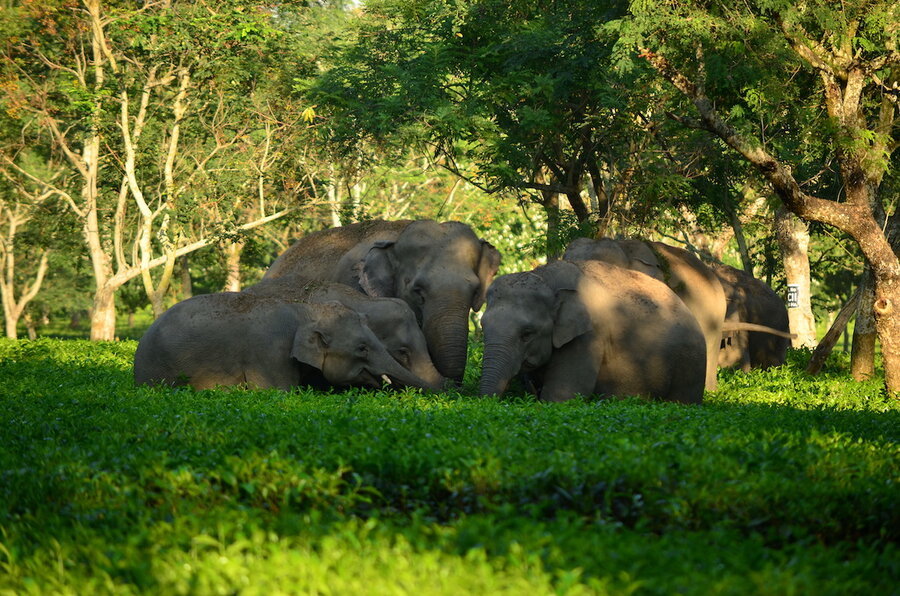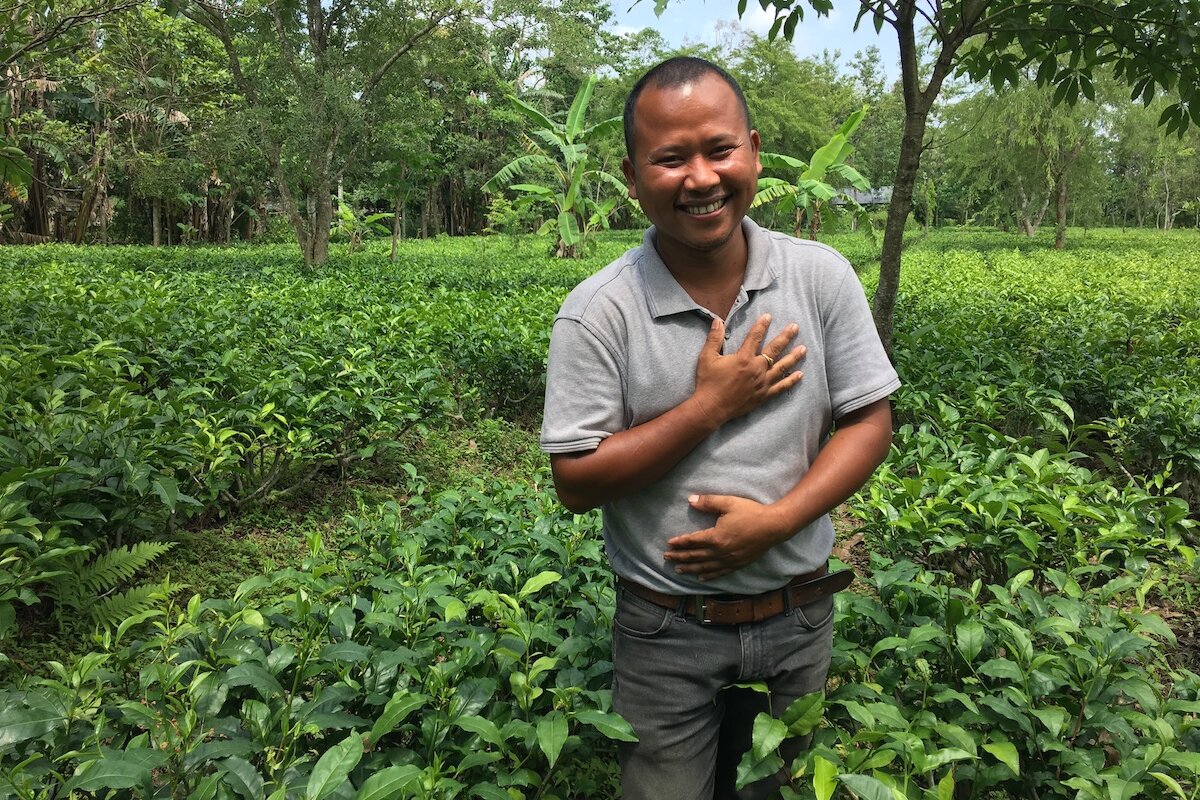Can India's wild elephants find a haven in tea gardens?
Loading...
It was a full moon. Tenzing Bodosa awoke, disturbed by a sound in his tea gardens. Looking out of his porch he saw a herd of wild elephants under the silvery light, with the calves frolicking, the mother munching on the luxuriant grass, and the male elephant standing guard.
For many tea farmers in India, seeing a herd of wild elephants amid the crops is cause for alarm. But for Mr. Bodosa, who employs more than 70 workers at two farms in Assam’s Udalguri district, it meant everything was working just as he planned.
His operations, which he calls the “world’s first elephant-friendly tea farm,” were certified in 2016 by the Certified Elephant Friendly Tea Program, a partnership between the Wildlife Friendly Enterprise Network (WFEN) and the University of Montana.
Why We Wrote This
Interactions between humans and wildlife need not be a zero-sum game. In India, some farmers are showing how elephants and tea farmers can peacefully coexist.
“Certification can come about in different ways,” says Julie Stein, executive director and co-founder of WFEN. “Sometimes we become aware of exemplary farmers who are thought leaders, sometimes tea growers reach out to us to see if they qualify, sometimes tea brands may contact us to see if their suppliers qualify.”
Ms. Stein says the program conducts a full field audit before certification. Consumers pay a premium for this tea, which is sourced from plantations that protect elephant habitats, reduce barriers and ditches to facilitate the easy movement of elephants, and ensure safe disposal of chemicals.
“A voluntary certification program like ours can allow consumers to vote with their wallets on issues that are important to them,” Ms. Stein says.
A species in peril
The IUCN Red List classifies Asian elephants as an endangered species, with about 40,000 to 50,000 remaining across their range countries, a decline of more than 50% in the last 75 years. According to Sandeep Tiwari, program manager of the IUCN’s Asian Elephant Specialist Group, India is home to about 28,000 wild elephants. “Many reasons have led to this,” he says, “from fragmentation, degradation, and loss of habitat to poisoning, electrocution, poaching, and elephant-man conflict.”
One of the surprising reasons for the declining population is connected to tea cultivation. India is the second-largest tea grower after China, and Assam leads tea production. Assam has a population of 5,719 wild elephants, the most after the state of Karnataka. Elephants perceive tea gardens as extensions of their forest habitat, as they have been part of their migratory routes over centuries. They quite often use them to rest in the daytime, to eat food and drink water, and to give birth.
In India, interactions between humans and wild elephants often end badly for members of both species. Elephants kill more than 400 people – many of them tea garden workers – in the country each year. Sometimes, due to lack of natural forage, elephants enter villages to raid crops, and villagers pelt them with stones or hit them with sticks to drive them out. Many calves are trapped in the ditches that are dug for drainage in tea estates.
Most tea plantations date back to British colonial times, when government wastelands were given on lease to tea companies. In Assam, home to most of India’s tea plantations, elephant corridors are shrinking.
“Very often the elephants would destroy fences, uproot trees, and terrorize the employees,” says Mr. Bodosa. “That was when I got the idea that there must be a way to coexist peacefully.”
Mr. Bodosa has been growing tea organically since 2007, when he was one of the few farmers using natural products like cow manure, bone meal, and urine. He realized that using artificial fertilizers and pesticides was not only harmful to those farming but also to the final product. “I thought that something that people start their day with, a cup of tea, can’t be full of poison,” he says.
Mr. Bodosa picked up the nuts and bolts of organic farming from a Canadian nongovernmental organization, and later Dr. L Narayana Reddy, an organic farmer in Bengaluru who taught him composting. Mr. Bodosa planted plants and trees like litchi, guava, and jackfruit; used local leaves as pesticides; and brought about an ecological balance on his farm.
To make his farms elephant-friendly, he created a buffer zone for them, planting it with vegetation that the elephants are fond of, from elephant grass and elephant apples to bamboo and star fruit; made a tank with stored water; and provided them easy passage by making sure there were no ditches, fences, or barriers. Hornbills, mongooses, peacocks, and deer frequent his tea gardens. Many human visitors come to his farms, and even stay in a treehouse that he has built, and volunteer.
Mr. Bodosa has also trained as many as 70,000 farmers from neighboring states like Sikkim, Nagaland, and Arunachal Pradesh in organic farming. WFEN and the University of Montana have funded a reforestation project here, where women grow native trees and schoolchildren help plant trees for elephant habitats.
Securing a “lasting peace”
The 1,200 acre Nuxalbari Tea Estate in Darjeeling, established in 1884 and run by fifth-generation owner Sonia Jabbar, was the first large tea estate to be certified elephant-friendly, though Ms. Jabbar has since opted out of the program.
The estate, which lies in the middle of an elephant corridor, has been working for years to help wild elephants in the area. Actions include creating elephant pools; planting native trees, shrubs, and grasses so that elephants have shelter and forage; implementing an early warning system for workers; and training estate security to keep elephant corridors free. Nuxalbari also has a club for workers’ children, educating them through games and films on conservation and climate change. Last year, Ms. Jabbar was awarded the Nari Shakti Puraskar, India’s highest civilian award for women.
Recently, she created the Hathi Sathi Foundation, which scales up the work at Nuxalbari Tea Estates to other tea estates and villages across north Bengal. “Human-elephant conflict is a colossal issue in these parts,” she says. “Now with a grassroots organization that focuses solely on conservation, we hope to bring lasting peace between humans and our majestic elephants.”
“We have to work hard to secure the lives of both wild elephants and humans,” she says.






